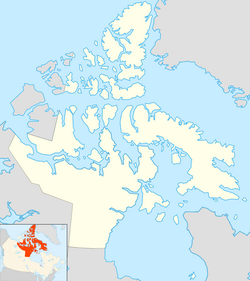Alert, Nunavut
| Alert | |
|---|---|
| Weather station and signals intelligence base | |

|
|
| Motto: Inuit Nunangata Ungata (Beyond the Inuit Land) | |
| Coordinates: 82°30′05″N 62°20′20″W / 82.50139°N 62.33889°WCoordinates: 82°30′05″N 62°20′20″W / 82.50139°N 62.33889°W | |
| Country | Canada |
| Territory | Nunavut |
| Region | Qikiqtaaluk Region |
| Population (2011) | |
| • Total | 0 to 5 |
| Time zone | EST (UTC-5) |
| • Summer (DST) | EDT (UTC-4) |
Alert, in the Qikiqtaaluk Region, Nunavut, Canada, is the northernmost permanently inhabited place in the world, at latitude 82°30'05" north, 817 kilometres (508 mi) from the North Pole. Its permanent population was reported as zero in the 2011 census, but military and scientific personnel on rotation were present. It takes its name from HMS Alert, which wintered 10 km (6.2 mi) east of the present station, off what is now Cape Sheridan, in 1875–1876.
Alert has many temporary inhabitants as it hosts a military signals intelligence radio receiving facility at Canadian Forces Station Alert (CFS Alert), as well as a co-located Environment Canada weather station, a Global Atmosphere Watch (GAW) atmosphere monitoring observatory, and the Alert Airport.
Alert is named after HMS Alert, a British ship which wintered about 10 km (6.2 mi) away in 1875–76. The ship's captain, George Nares, and his crew were the first recorded people to reach the northern end of Ellesmere Island.
Shortly after the end of World War II, Charles J. Hubbard began to rouse interest in the United States and Canada for the establishment of a network of Arctic stations. His plan, in broad perspective, envisaged the establishment of two main stations, one in Greenland and the other within the Archipelago, which could be reached by sea supply. These main stations would then serve as advance bases from which a number of smaller stations would be established by air. The immediate plans contemplated the establishment of weather stations only, but it was felt that a system of weather stations would also provide a nucleus of transportation, communications and settlements which would greatly aid programs of research in many other fields of science. It was recognized that ultimate action would depend on international co-operation since the land masses involved were under Canadian and Danish control.
...
Wikipedia

